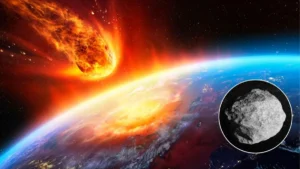
This March 24, 2024, the Earth experienced a geomagnetic storm of G4 intensity, the second most intense on the scale, caused by a coronal mass ejection from the Sun.
What are goemagnetic storms?
The geomagnetic storm, also called Solar storm is a temporary disturbance of the Earth’s magnetic field. These disturbances are caused by Earth’s interaction with the solar wind, which is a stream of charged particles that constantly flows from the Sun. These storms are more likely when there is greater solar activity, such as during solar maximum.
What effects does a geomagnetic storm have?
Geomagnetic storms They can have various effects on Earth, depending on its intensity. Some of the most common are:
- Northern and southern lights: They can be observed at higher latitudes (near the Arctic and Antarctica) due to the interaction of charged particles with the Earth’s atmosphere.
- Interruptions in radio and satellite communications: Radio and satellite signals can be affected by disturbances in the Earth’s magnetic field.
- Fluctuations in electrical networks: Currents induced in power grids by geomagnetic storms can cause damage to transformers and other equipment, which could lead to power outages.
- Problems with GPS navigation systems: The accuracy of GPS systems can be affected by geomagnetic storms.
Rating scale
The scale, established by the United States National Oceanic and Atmospheric Administration (NOAA), is based on the geomagnetic index Kp, which measures fluctuations in the Earth’s magnetic field. The G scale is made up of five levels, each representing a different degree of intensity and possible impacts:
- G1 – Minor: Corresponding to a Kp index of 5, these storms can cause slight effects on power grids, such as small power fluctuations, and can produce visible auroras at high latitudes.
- G2 – Moderate: With a Kp index of 6, these storms can cause more widespread auroras, as well as anomalous voltages in power systems and possible effects on satellites orbiting the Earth.
- G3 – Strong: represents a Kp index of 7, meaning that these storms can lead to more noticeable power fluctuations on power grids, difficulties in power grid control, and potential impacts on satellite navigation. Additionally, auroras may be visible at lower latitudes than normal.
- G4 – Severa: Corresponding to a Kp index of 8, these storms can cause serious problems in electrical systems, disruptions in satellite navigation and communications, as well as visible auroras at even lower latitudes.
- G5 – Extreme: With a Kp index of 9, these are the most severe solar storms. They can cause massive power grid failures, extensive damage to transformers, widespread disruptions to satellite communications and navigation, as well as auroras visible at very low latitudes.
- We asked ChatGPT how life arose on Earth – this was answered
What can be done?
Given the possibility of facing a large solar storm, Experts recommend that if authorities deem it necessary, preventive measures be taken to protect safety and well-being. Here are some strategies to prepare:
- Be informed: Stay up to date with space weather alerts and forecasts issued by agencies like NOAA. These alerts can provide advance information about potential solar storms and allow you to take preventive measures.
- Develop an emergency plan: Create an emergency plan for your home and family that includes actions to take in the event of a severe solar storm. Make sure all family members are aware of the plan and know how to execute it.
- Prepare supplies: Stock up on non-perishable food, drinking water, and essential medications for at least two weeks. It is also important to have extra batteries or external chargers for electronic devices in case of a prolonged power outage.
- Have alternative communication methods: Make sure you have access to alternative communication methods, such as shortwave radios or CB radios, as cell phone and internet networks can be affected during a solar storm.
- Invest in backup power: Consider investing in a portable generator and keeping it charged and ready to go. Make sure you have enough fuel safely stored to operate during an emergency.
- Protect electronic devices: Use surge protectors on your electronic devices and consider storing additional devices in a Faraday cage or electromagnetic shielding bags to prevent damage during a solar storm.
- Prepare your vehicle: Check that your vehicle is in good condition and has a full fuel tank. Vehicle electronic systems can also be affected by intense solar storms.
- Have cash available: Keep cash on hand, as electronic transactions and ATMs may not be available during an emergency.
- Collaborate with the community: Work together with your neighbors and the local community to develop emergency plans and share resources in the event of a severe solar storm.
- Acquire survival skills: Learn basic survival skills, such as first aid, water purification, and outdoor survival techniques, which can be useful during a prolonged crisis.
Source: https://www.noticiascaracol.com/actualidad/que-es-una-tormenta-geomagnetica-como-la-que-golpeo-este-24-de-marzo-la-tierra-so35


